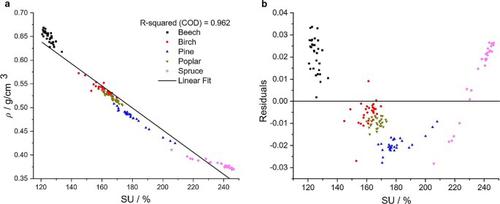European Journal of Wood and Wood Products ( IF 2.6 ) Pub Date : 2024-02-09 , DOI: 10.1007/s00107-024-02056-4 Johannes Karthäuser , Vladimirs Biziks , Daniel Roggatz , Holger Militz

|
Phenol-formaldehyde resins can be used for wood modification through an impregnation process and subsequent curing within the wood cell wall. Phenol is gained from non-renewable resources, and its substitution by renewable chemicals has been a research goal. A promising example for renewable phenol substituents are lignin-derived organic chemicals. Phenol-formaldehyde resins with such substitutions have been studied, however, knowledge of their application for wood modification is deficient. While there are attempts to modify pine and beech wood with this method, studies on other wood species are scarce. Considering the increasing use of different wood species in wood industry, determining the influence of the wood species on the modification quality is an important research goal. Therefore, in this study, vacuum-pressure impregnation of five wood species – Scots pine sapwood (Pinus sylvestris), Norway spruce (Picea abies), European beech (Fagus sylvatica), Silver birch (Betula pendula), and European aspen sapwood (Populus tremula) – with phenol-formaldehyde resins is described. Here, up to 45% of the phenol in the synthetic resin is substituted by vacuum low-temperature microwave-assisted pyrolysis cleavage products from commercial softwood kraft lignin. The solution uptake, weight% gain, leaching, and anti-swelling efficiency of the modified wood are analyzed and compared. The results indicate that up to 30% of the phenol can be substituted without significant decreases in the performance of the modification. The method gives comparable results for most of the wood species described herein, with exception of beech wood, for which the modification had a lower quality. The results could help to develop more environmentally friendly wood modification methods for several common European wood species.
中文翻译:

利用软木牛皮纸木质素的热解裂解产物代替酚醛树脂中的苯酚来改性不同的木材品种
酚醛树脂可通过浸渍过程和随后在木材细胞壁内固化来用于木材改性。苯酚是从不可再生资源中获得的,用可再生化学品替代它一直是一个研究目标。可再生苯酚取代基的一个有前景的例子是木质素衍生的有机化学品。具有此类取代基的苯酚甲醛树脂已被研究,然而,对其在木材改性中的应用的了解还不够。虽然有人尝试用这种方法对松木和山毛榉木进行改性,但对其他木材品种的研究却很少。考虑到木材工业中不同木种的使用不断增加,确定木种对改性质量的影响是一个重要的研究目标。因此,在本研究中,对五种木材进行真空压力浸渍——欧洲赤松边材(Pinus sylvestris)、挪威云杉(Picea abies)、欧洲山毛榉(Fagus sylvatica)、银桦(Betula pendula)和欧洲白杨边材(Populus) Tremula ) – 描述了酚醛树脂。在这里,合成树脂中高达 45% 的苯酚被商业软木牛皮纸木质素的真空低温微波辅助热解裂解产物所取代。对改性木材的溶液吸收、增重、浸出和抗膨胀效率进行了分析和比较。结果表明,最多可以取代 30% 的苯酚,而不会显着降低改性性能。该方法对本文描述的大多数木材树种给出了可比较的结果,但山毛榉木除外,对于山毛榉木来说,改性的质量较低。研究结果可能有助于为几种常见的欧洲木材品种开发更环保的木材改性方法。



























 京公网安备 11010802027423号
京公网安备 11010802027423号